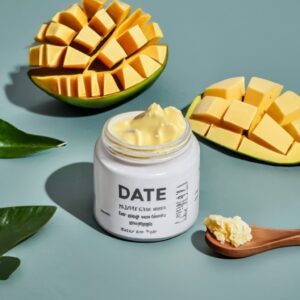
Indulge your senses in the tropical allure of our Mango Body Butter, a luscious and hydrating treat for your skin. Crafted with the finest natural ingredients, this body butter is designed to lavish your skin with the sumptuous essence of ripe mangoes while providing deep and lasting moisturization. Immerse yourself in the revitalizing and fruity fragrance as the velvety texture melts into your skin, leaving it feeling irresistibly soft and rejuvenated. Elevate your skincare routine with the exotic and nourishing experience of our Mango Body Butter – because your skin deserves nothing less than the luxury of tropical indulgence.
What is the purpose of Body Butter?
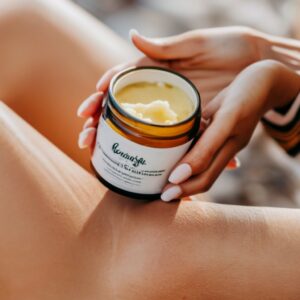
Using body butter offers a range of benefits for your skin, making it a luxurious addition to your skincare routine. Here are some compelling reasons why you should consider incorporating body butter into your daily regimen:
- Intense Moisturization:
- Body butter is rich in emollients and natural oils, providing deep hydration to dry and thirsty skin. It helps replenish and lock in moisture, leaving your skin feeling incredibly soft and supple.
- Long-Lasting Hydration:
- Unlike some water-based moisturizers, body butter tends to be thicker and more concentrated. This means it forms a protective barrier on the skin, preventing moisture loss and ensuring lasting hydration throughout the day.
- Nourishment for Dry Skin:
- Body butter is especially effective for individuals with dry or flaky skin. It contains nourishing ingredients like shea butter, cocoa butter, or mango butter, which are known for their skin-conditioning properties.
- Rich in Essential Nutrients:
- Many body butters are infused with vitamins and antioxidants, providing essential nutrients that promote skin health. These ingredients contribute to the rejuvenation and overall well-being of your skin.
- Enhanced Skin Elasticity:
- Regular use of body butter can help improve skin elasticity, making it feel firmer and more supple. This is particularly beneficial in areas prone to dryness, such as elbows, knees, and heels.
- Luxurious Aromatherapy:
- Body butters often come in a variety of pleasing scents, offering a delightful aromatherapeutic experience. The pleasing fragrances can uplift your mood and contribute to a sense of relaxation and well-being.
- Targeted Skin Treatment:
- Some body butters are formulated to address specific skin concerns, such as stretch marks, scars, or uneven skin tone. These specialized formulations provide targeted care for problem areas.
- Versatility in Application:
- Body butter is versatile and can be applied to various parts of your body, from head to toe. Whether you’re looking to moisturize dry hands, elbows, or heels, body butter offers a comprehensive solution for overall skin care.
mango butter Benefits
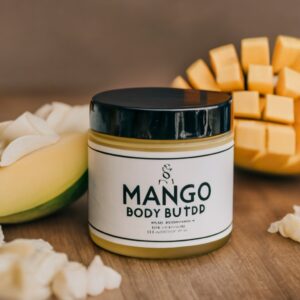
Mango body butter offers a host of benefits for your skin, combining the nourishing properties of mango extract with other skin-loving ingredients. Here are some key advantages of using mango body butter:
Intense Hydration:
Mango body butter is rich in natural emollients and fatty acids, providing deep hydration to the skin. It helps combat dryness, leaving your skin moisturized and supple.
Rich in Vitamins:
Mangoes are loaded with vitamins A and C, essential for maintaining healthy skin. These vitamins contribute to skin renewal, collagen production, and protection against environmental damage.
Antioxidant Protection:
The high antioxidant content in mango body butter helps protect the skin from free radicals, which can cause premature aging. It supports the skin’s natural defense mechanisms.
Soothing and Calming:
Mango butter has soothing properties, making it ideal for calming irritated or sensitive skin. It helps reduce redness and discomfort, promoting a more comfortable skin experience.
Improves Skin Elasticity:
Regular use of mango body butter can enhance skin elasticity, making it firmer and more resilient. This is particularly beneficial for areas prone to stretching, such as the abdomen and thighs.
Smoothing and Softening:
The emollient nature of mango body butter helps smooth rough patches and soften the skin’s texture. It leaves your skin feeling velvety smooth and touchably soft.
Promotes Collagen Production:
Vitamin A in mango contributes to collagen production, supporting the skin’s structure. This can help improve skin firmness and reduce the appearance of fine lines and wrinkles.
Natural Glow:
Mango body butter imparts a natural radiance to the skin, giving it a healthy and vibrant glow. It helps revitalize dull and tired-looking skin.
Pleasant Fragrance:
Mango body butter often comes with a delightful tropical fragrance. The pleasant scent can uplift your mood and provide a refreshing sensory experience.
Versatile Application:
Mango body butter can be applied to various areas of the body, offering a versatile solution for overall skincare. It is particularly effective for dry elbows, knees, and heels.
Best ingredients for mango body butter
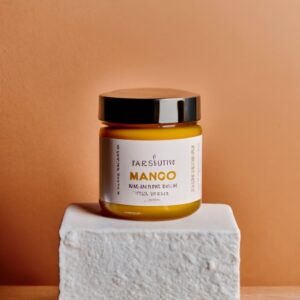
Creating a luxurious and effective mango body butter involves selecting high-quality ingredients that complement the nourishing properties of mango. Here are some excellent ingredients to consider when making mango body butter:
- Mango Butter:
- Naturally extracted from the mango seed, mango butter is rich in fatty acids and antioxidants. It provides deep moisturization, promotes skin elasticity, and contributes to a smooth texture.
- Shea Butter:
- Renowned for its moisturizing properties, shea butter complements mango butter by offering additional hydration. It helps soothe and soften the skin, leaving it supple and nourished.
- Coconut Oil:
- Coconut oil is a lightweight yet highly moisturizing oil that absorbs easily into the skin. It adds a smooth texture to the body butter while providing additional hydration.
- Sweet Almond Oil:
- Rich in vitamins A and E, sweet almond oil helps nourish and revitalize the skin. It contributes to the overall softness and promotes a healthy glow.
- Jojoba Oil:
- Known for its similarity to the skin’s natural oils, jojoba oil helps balance moisture levels. It’s easily absorbed and assists in maintaining skin elasticity.
- Vitamin E Oil:
- Vitamin E is a powerful antioxidant that helps protect the skin from free radicals. It contributes to the body butter’s shelf life and promotes skin health.
- Arrowroot Powder (Optional):
- Arrowroot powder can be added to enhance the body butter’s texture. It helps reduce greasiness and contributes to a smoother application.
- Essential Oils (Optional):
- Consider adding essential oils for fragrance and additional skin benefits. Popular choices include citrus oils like orange or bergamot, which complement the tropical aroma of mango.
- Aloe Vera Gel:
- Aloe vera provides soothing and calming properties, making it an excellent addition to relieve irritated or sun-exposed skin.
- Cornstarch (Optional):
- Cornstarch can be used to improve the body butter’s consistency. It helps prevent a greasy feel and ensures a velvety texture upon application.
Equipment list for mango butter
Remember to clean and sanitize all equipment before use to maintain a hygienic environment for your DIY skincare project. Adjust the quantities and sizes of containers based on the amount of body butter you plan to make.To make Mango Body Butter, you’ll need a few essential tools and equipment. Here’s a list of items you might find useful in the process:
- Double Boiler or Heatproof Bowl:
- For melting and combining the ingredients without direct heat.
- Spatula or Spoon:
- To stir and mix the ingredients during the melting process.
- Measuring Cups and Spoons:
- Accurate measurements are crucial for a well-balanced body butter.
- Weighing Scale:
- Useful for precise measurements, especially when working with solid ingredients like butters.
- Hand Mixer or Stand Mixer:
- To whip the body butter into a light and fluffy consistency during the cooling process.
- Glass Jars or Containers:
- Clean, airtight jars for storing the finished body butter.
- Pot (for Double Boiler Method):
- If you’re using the double boiler method, you’ll need a pot to hold water.
- Labels (Optional):
- To label your finished product with ingredients, date, and any additional information.
- Fridge:
- A refrigerator to cool the mixture before whipping.
- Clean Towels or Paper Towels:
- To wipe down any utensils or surfaces during the process.
- Small Funnel (Optional):
- Useful for transferring the whipped body butter into jars without making a mess.
- Small Cosmetic Jars or Containers (Optional):
- If you prefer smaller containers for gifting or travel-sized portions.
mango body butter recipes
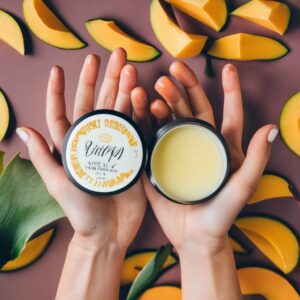
Ingredients:
- 1/2 cup Mango Butter
- 1/4 cup Shea Butter
- 1/4 cup Coconut Oil
- 2 tablespoons Sweet Almond Oil
- 1 tablespoon Jojoba Oil
- 1 teaspoon Vitamin E Oil
- 1-2 tablespoons Arrowroot Powder (optional for texture)
- 10-15 drops Essential Oil (optional for fragrance, e.g., orange or bergamot)
- 1 tablespoon Aloe Vera Gel (optional for soothing properties)
Instructions:
- Prepare Your Work Area:
- Ensure all utensils and containers are clean and dry.
- Measure and Combine Butters and Oils:
- In a heat-safe bowl, measure and combine 1/2 cup Mango Butter, 1/4 cup Shea Butter, 1/4 cup Coconut Oil, 2 tablespoons Sweet Almond Oil, 1 tablespoon Jojoba Oil, and 1 teaspoon Vitamin E Oil.
- Melt the Ingredients:
- Create a double boiler by placing the bowl over a pot of simmering water (or use a microwave). Gently melt the ingredients until fully liquid.
- Optional Additions:
- If using, add 1-2 tablespoons of Arrowroot Powder for texture. Stir until well combined.
- Cool Slightly:
- Allow the mixture to cool slightly before adding essential oils and aloe vera gel. Stir well to incorporate.
- Chill in the Fridge:
- Place the mixture in the fridge for about 20-30 minutes or until it starts to solidify around the edges.
- Whip the Body Butter:
- Using a hand mixer or stand mixer, whip the partially solidified mixture until it becomes light and fluffy. This step may take several minutes.
- Transfer to Jars:
- Scoop the whipped body butter into clean, airtight jars.
- Store and Enjoy:
- Store your homemade Mango Body Butter in a cool, dry place. Apply as needed for soft, nourished skin.
Feel free to adjust ingredient quantities based on your preferences and the desired texture of the body butter. Experimenting with essential oils allows you to personalize the fragrance according to your liking.
Mango Mint Body Butter
Experience a burst of tropical freshness with our Mango Mint Body Butter. This invigorating blend of mango butter, shea butter, and peppermint promises to revitalize your skin. Indulge in the luscious fusion of sweet mango and cooling mint, leaving your skin refreshed, moisturized, and irresistibly fragrant. Elevate your self-care routine with nature’s goodness in a jar. Welcome to a rejuvenating journey of skincare bliss!
Ingredients:
- 1/2 cup Mango Butter
- 1/4 cup Shea Butter
- 2 tablespoons Coconut Oil
- 2 tablespoons Sweet Almond Oil
- 1 tablespoon Jojoba Oil
- 1 teaspoon Vitamin E Oil
- 10-15 drops Peppermint Essential Oil (adjust to preference)
- 1 tablespoon Aloe Vera Gel (optional)
- 1-2 tablespoons Arrowroot Powder (optional for texture)
Instructions:
- Prepare Your Work Area:
- Ensure all utensils and containers are clean and dry.
- Melt the Butters and Oils:
- In a double boiler or using a heatproof bowl over simmering water, melt the Mango Butter, Shea Butter, Coconut Oil, Sweet Almond Oil, Jojoba Oil, and Vitamin E Oil. Stir until fully melted.
- Optional Additions:
- If desired, add 1-2 tablespoons of Arrowroot Powder for a smoother texture. Stir until well combined.
- Add Peppermint Essential Oil and Aloe Vera Gel:
- Allow the mixture to cool slightly, then add 10-15 drops of Peppermint Essential Oil and the optional Aloe Vera Gel. Stir well to incorporate.
- Chill in the Fridge:
- Place the mixture in the fridge for about 20-30 minutes or until it starts to solidify around the edges.
- Whip the Body Butter:
- Using a hand mixer or stand mixer, whip the partially solidified mixture until it becomes light and fluffy. This step may take several minutes.
- Check Consistency:
- If needed, adjust the consistency by placing the body butter in the fridge for a short time before whipping again.
- Transfer to Jars:
- Scoop the whipped Mango Mint Body Butter into clean, airtight jars.
- Store and Enjoy:
- Store in a cool, dry place. Apply as needed for soft, nourished skin, and experience the invigorating combination of mango and mint.
Shelf life and storage
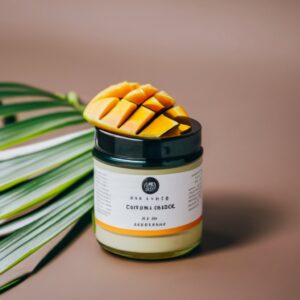
Proper storage and understanding the shelf life of your Mango Body Butter are crucial for maintaining its quality and effectiveness. Here’s a guide:
Storage:
- Cool, Dry Place: Store your Mango Body Butter in a cool, dry place away from direct sunlight. Exposure to heat and light can alter the texture and reduce the shelf life.
- Airtight Container: Use airtight jars or containers to prevent air and moisture from affecting the body butter. This helps maintain its consistency and prevents it from drying out.
- Avoid Humidity: Keep the body butter away from high humidity, as excess moisture can lead to mold growth and spoilage.
- Refrigeration (Optional): While not necessary, refrigerating the body butter can provide a refreshing sensation when applied. However, it’s essential to use airtight containers to prevent absorption of odors from the refrigerator.
Shelf Life:
The shelf life of your Mango Body Butter depends on several factors, including the quality of ingredients used and storage conditions.
- Typical Shelf Life: Mango Body Butter, when stored properly, can have a shelf life of approximately 6 months to 1 year.
- Check Ingredients’ Best-Before Dates: Consider the expiration dates of individual ingredients, especially oils and butters, as they can impact the overall shelf life of the body butter.
- Look for Signs of Spoilage: If you notice changes in color, smell, or texture, or if the body butter develops an off-putting odor, it may have spoiled. Discontinue use if any signs of spoilage are evident.
- Use Clean Hands or Tools: To extend the shelf life, always use clean and dry hands or tools when scooping out the body butter to minimize the introduction of contaminants.
- Small Batches: Consider making smaller batches of body butter to ensure you can use it within a reasonable time frame.
FAQ’S
What is mango body butter good for?
- Mango body butter is excellent for moisturizing and nourishing the skin. Packed with essential fatty acids, it helps combat dryness, improves skin elasticity, and leaves the skin feeling soft and supple. The natural emollients in mango butter make it a luxurious choice for promoting overall skin health.
Does mango butter lighten skin?
- Mango butter is not typically known for lightening the skin. Its primary benefits lie in moisturizing and soothing properties. While it may contribute to a healthy skin tone by providing hydration and nourishment, it is not considered a skin-lightening agent.
Is mango butter better than shea?
- The choice between mango butter and shea butter depends on individual preferences and skin needs. Mango butter is lighter and less greasy, making it suitable for those who prefer a lighter texture. Shea butter tends to be more dense and richer, providing intense hydration. Both offer excellent moisturizing properties, and the preference often comes down to personal skin type and texture preferences.
What does mango body butter smell like?
- Mango body butter has a natural, sweet, and tropical fragrance reminiscent of fresh mangoes. The scent is often light and refreshing, providing a pleasant sensory experience when applied to the skin.
Is mango butter OK for face?
- Yes, mango butter is generally safe for facial use. Its lightweight and non-comedogenic nature make it suitable for most skin types. However, as with any skincare product, it’s recommended to patch-test first, especially for those with sensitive skin, to ensure there are no adverse reactions.
Is mango butter good for dark skin?
- Mango butter is suitable for all skin tones, including dark skin. Its hydrating and nourishing properties benefit skin health, promoting a radiant and healthy complexion. Darker skin tones, like any other, can enjoy the moisturizing benefits of mango butter.
Does mango butter have SPF?
- Mango butter does not provide significant sun protection on its own. While it contains some natural antioxidants that may offer minor protection against UV rays, it should not be relied upon as a substitute for dedicated sun protection products with SPF.
Is mango Body Butter safe?
- Yes, mango body butter is generally safe for use. It is a natural product derived from the seeds of the mango fruit and is well-tolerated by most individuals. However, those with specific allergies or sensitivities should check the ingredient list and perform a patch test before widespread use.
Is mango butter oily?
- Mango butter has a relatively low greasiness compared to some other butters. It is considered a drier butter, meaning it absorbs into the skin more quickly, leaving a less oily residue. However, individual experiences may vary, and the amount applied can influence the perceived oiliness.
